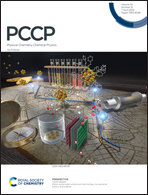Dynamic Pt–OH−·H2O–Ag species mediate coupled electron and proton transfer for catalytic hydride reduction of 4-nitrophenol at the confined nanoscale interface†
Abstract
Generally, the catalytic transformation of 4-nitrophenol (4-NP) to 4-aminophenol (4-AP) at heterogeneous metal surfaces follows a Langmuir–Hinshelwood (L–H) mechanism when sodium borohydride (NaBH4) is used as the sacrificial reductant. Herein, with Pt–Ag bimetallic nanoparticles confined in dendritic mesoporous silica nanospheres (DMSNs) as a model catalyst, we demonstrated that the conversion of 4-NP did not pass through the direct hydrogen transfer route with the hydride equivalents being supplied by borohydride via the bimolecular L–H mechanism, since Fourier transform infrared (FTIR) spectroscopy with the use of isotopically labeled reactants (NaBD4 and D2O) showed that the final product of 4-AP was composed of protons (or deuterons) that originated from the solvent water (or heavy water). Combined characterization by X-ray photoelectron spectroscopy (XPS), 1H nuclear magnetic resonance (NMR) and the optical excitation and photoluminescence spectrum evidenced that the surface hydrous hydroxide complex bound to the metal surface (also called structural water molecules, SWs), due to the space overlap of p orbitals of two O atoms in SWs, could form an ensemble of dynamic interface transient states, which provided the alternative electron and proton transfer channels for selective transformation of 4-NP. The cationic Pt species in the Ag–Pt bimetallic catalyst mainly acts as a dynamic adsorption center to temporally anchor SWs and related reactants, and not as the active site for hydrogen activation.



 Please wait while we load your content...
Please wait while we load your content...